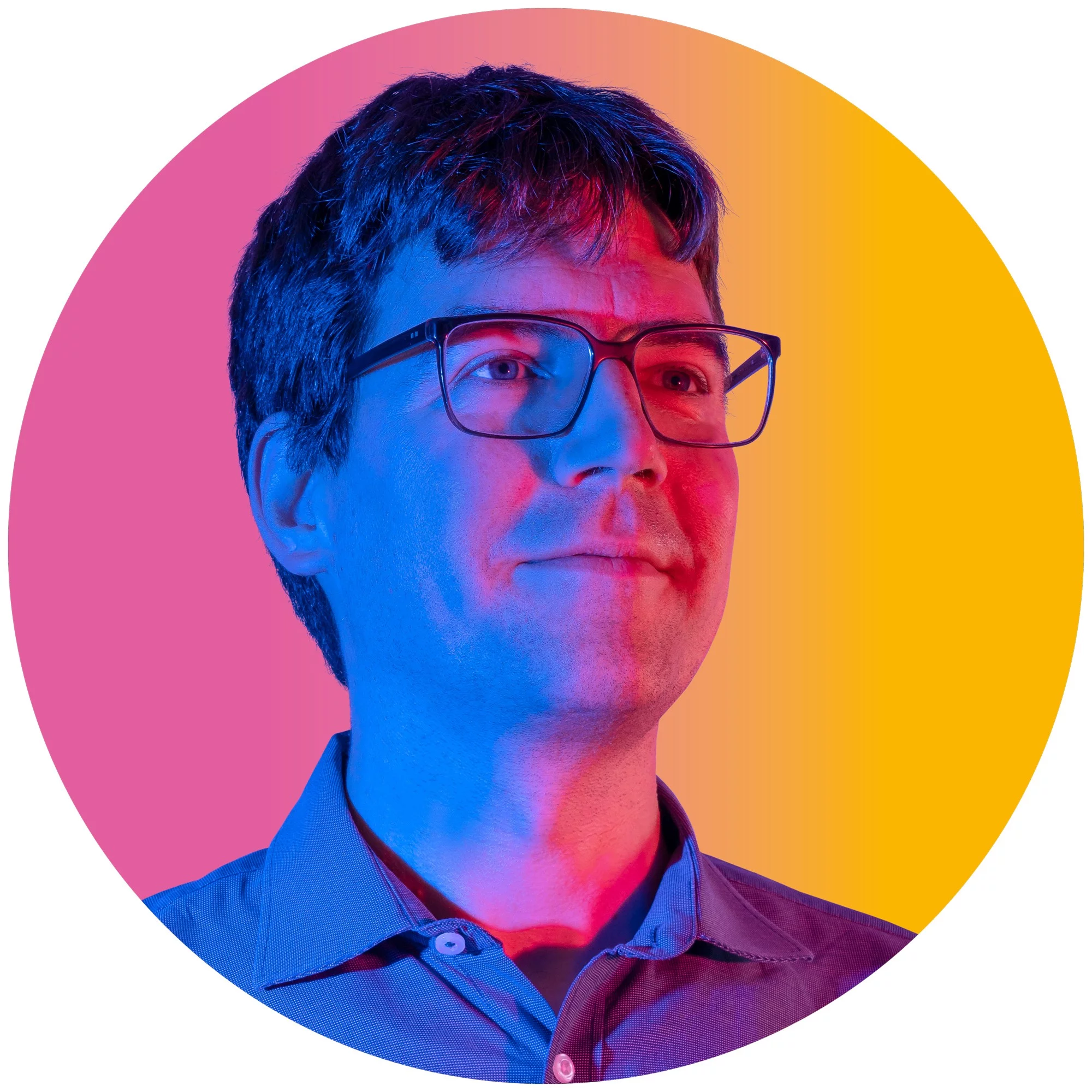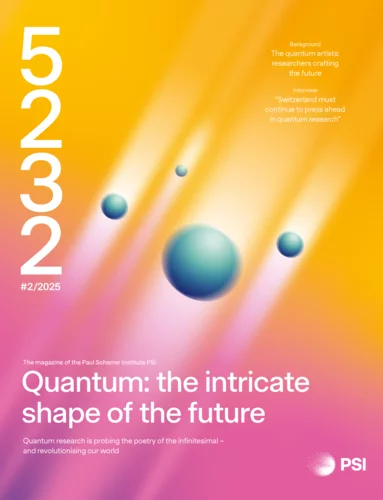The quantum artists: Slowing time and trapping ions
Cornelius Hempel uses quanta to perform calculations on quantum phenomena. While this sounds logical, it’s actually highly complex. His latest coup: a quantum simulator that slows down time.
How nice it would be if one could slow down time. Looking in the mirror wouldn’t reveal a new wrinkle every morning; and a wonderful holiday could be drawn out a little. Cornelius Hempel has relatively few wrinkles. However, this is probably because the physicist at the PSI Center for Photon Science is just 44 years old, rather than a result of the machine his team has built in a windowless laboratory – a seemingly chaotic jumble of cables, lenses and lasers. And yet: It slows down time – at least in complex calculations. The machine is a quantum computer based on an ion trap, and Hempel uses it to simulate ultrafast chemical reactions in slow motion. It cannot be used to prevent wrinkles.
Cornelius Hempel explains that his quantum simulator is actually an atomic clock. Both work with ions – that is, electrically charged atoms – captured in a trap, whose electrons are made to oscillate using lasers, much like a pendulum swinging back and forth in an old clock. The first atomic clocks, built in the 1950s, were driven by microwaves. They continue to form the basis of how we measure time, and their oscillations define the second – around 9.1 million oscillations correspond to one second. Atomic clocks achieve this with an accuracy of 16 decimal places, meaning they would be off by no more than about one second every 100 million years. Today’s ion-based models are a thousand times more accurate. “Nothing else can be measured more accurately than time,” says Hempel.
Hempel uses the atomic clock as a quantum simulator, a controllable quantum system that can replicate another quantum system – often a solid or a liquid. The behaviour of quantum systems is best calculated using quantum computers – Richard Feynman, winner of the Nobel Prize in physics, had already proposed this in 1982. For a long time, Feynman’s concept lay dormant. The idea was not pursued further until the 1990s; the first prototype of a quantum computer based on an ion atomic clock was demonstrated in 1995.
Atomic nuclei, vibrating naturally
Over the last decade, quantum computers have made such great progress that they are now ideally suited to serve as quantum simulators. This gives physicists a new and powerful tool they can use to calculate the behaviour of molecules – that is, groups of different atoms – right down to the quantum physical details. Even the fastest supercomputers often fall short here. But to obtain meaningful results, researchers have until now had to treat the atomic nuclei as though they were frozen in space; the supercomputer only calculates how the electrons move around the nuclei. However, this is unrealistic. “The atomic nuclei actually vibrate, and they should do so in the simulation,” says Hempel. The quantum simulator is a promising approach because the nuclei vibrate naturally in their trap.
The disadvantage of a quantum simulator is that it cannot achieve the ultrafast pace of phenomena in the world of molecules and atoms. Instead, its speed corresponds to that of the underlying quantum system. This is where the “time-brake” comes in. It uses a mathematical model that matches the system being simulated to describe the behaviour of the ions in the experiment – but with a time-stretching factor of 100 billion. In fact, Hempel doesn’t slow down the quantum system itself, but rather the way it is represented in the mathematical model.
Extremely small and incredibly fast: Atomic nuclei vibrate on a timescale of ten quadrillionths of a second. Many other processes in the world of atoms and molecules also occur incredibly quickly. This makes them difficult to observe in a laboratory setting. Cornelius Hempel has found a solution. He has built a simulator that mimics other quantum systems. His quantum simulator contains a mathematical “gearbox” that stretches out the passage of time. That way, Hempel can study lightning-fast processes as if in slow motion. © Studio HübnerBraun
Lightning-fast information in the eye
Ultrafast chemical reactions occur naturally in a wide variety of settings. They prevent us from constantly getting sunburnt by converting incoming ultraviolet radiation that reaches our genes into heat before it can cause damage. Very rapid chemical reactions also occur in the retina, for example. The molecule retinal translates incoming light into information, which the optic nerve then transmits to the brain. When a light particle – known as a photon – strikes it, the curved molecule straightens out at lightning speed, stimulating the optic nerve. Other PSI research groups are investigating this process experimentally using the X-ray free-electron laser SwissFEL. Retinal reacts within only around 400 femtoseconds, or just under half a trillionth of a second. In Hempel’s quantum simulator, however, the calculation takes place at a leisurely pace, in a matter of milliseconds. This has the advantage that the researcher can study exactly what happens when the molecule is deformed and how the atoms interact.
A quantum simulator usually works as an analogue system; a quantum computer, on the other hand, is digital. The qubits of a quantum computer know the binary states 0 and 1, on which classical computing is based – but with a difference. Qubits can exist in both states at the same time, to different degrees. This greatly increases their computing power for certain tasks.
Retinal is a molecule found in the retina of the eye. When light strikes it, the molecule changes its shape, and a signal is sent to the brain. This takes just under half a trillionth of a second. Cornelius Hempel mimics this process with his quantum simulator. The extremely high temporal resolution he achieves complements the experimental investigations of other PSI researchers. © Studio HübnerBraun
Digital fodder for analogue quantum computers
What if you could combine a quantum simulator and a quantum computer, that is, the analogue and digital modes? The result would be a quantum simulator that could be fed with digital information. Andreas Elben and Andreas Läuchli, members of the PSI Center for Scientific Computing, Theory and Data, have described how to combine the best of both worlds in a groundbreaking publication in Nature, one of the most renowned scientific journals. Working alongside researchers from Google and universities in five countries, they have demonstrated that just 69 qubits on a Google quantum computer can be used to calculate quantum dynamic processes such as heat propagation in a liquid, for example when two substances at different temperatures are mixed in a chemical reaction.
This concept paves the way for a universal quantum simulator and is to be used in many different areas of physics. Cornelius Hempel’s ion traps are also suitable for creating a universal quantum simulator.
Quantum phenomena are present in many current and future products to which our work can make a crucial contribution.
Sluggish sparrows on a power line
Hempel has arranged several dozen ions in a chamber, lining them up like sparrows on a power line. To make them perform calculations, he needs to stimulate them from the outside with a laser beam – not a problem with this number. However, if the aim is to host millions of qubits on a single chip, the lasers will have to be integrated on the chip in such a way that they can be switched on and off individually – a challenge in integrated photonics. While this technology already exists in data centres today, the integrated lasers used there are too large and emit light at wavelengths in the deep infrared range; quantum computers require visible light. “That’s why we are developing these technologies ourselves at PSI,” says Cornelius Hempel. Perhaps one day this will lead to hybrid processors that combine the atoms and lasers of a quantum computer with conventional silicon electronics.
These technologies are still some way from commercial application. There are other groups at PSI working on closing this gap, including Kirsten Moselund’s team in the Laboratory for Nano- and Quantum Technologies at the PSI Center for Photon Science.
And many industries – including electronics, measurement technology, and photonics – are already seeing benefits from the developments surrounding quantum computers. “A great deal of research at PSI focuses on phenomena that we would very much like to understand down to the level of quantum physics,” Cornelius Hempel emphasises. “And quantum phenomena are present in many current and future products, to which our work can then make a crucial contribution.”







